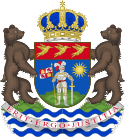Federated States of Gapla
This article or section is in the middle of an expansion or major restructuring. You are welcome to assist in its construction by editing it as well. If this article has not been edited in several days, please remove this template. |
Federated States of Gapla | |
|---|---|
| Motto: "Erit Ergo Justitia" (Latin) "Justice will be Served" | |
| Anthem: "Hail Gaplastovia" | |
| State seal | |
| Capital | New Gaplastovia |
| Largest city | Sweet Falls |
| Official languages | |
| Ethnic groups (only residents counted) |
|
| Religion (only residents counted) |
|
| Demonym(s) | Gaplan |
| Government | Federative Representative Constitutional Monarchy |
• Monarch | Wyatt of the Danubias |
| Chelsea Chen (PLP) | |
| Connor Holdsworth (RRP) | |
| Legislature | National Assembly (de jure) Council of Ministers (de facto) |
| Establishment | |
• Establishment of Gapla-Phoenix | 24 August 2015 |
• Restoration of Gapla-Phoenix | 28 February 2019 |
• Union day and federation | 6 March 2019 |
• First constitution ratified | 23 March 2019 |
• Current form (Federated States of Gapla) | 2 May 2019 |
| 10 September 2019 | |
• Current constitution | 5 April 2023 |
• Grand Reformation | 16 June 2023 |
| Area | |
• Total | 28.4 km2 (11.0 sq mi) Not including Gaplan Antarctica |
| Population | |
• 2024 estimate | 350 |
| Currency | Gapla Dollar (GPD) |
| Time zone | Time in Gapla |
| Date format | YYYY - MM - DD |
| Driving side | right |
| Internet TLD | .gx |
Website my | |
The Federated States of Gapla, commonly known as simply Gapla and co-officially the Gaplan Federation, is a country primarily located in southeastern Europe, along the Danube River. It borders Croatia to the west and shares a river border with Serbia to the east, and is regarded as a micronation by the external community. A federation of two constituent dominions (consisting of five precincts) and three territories, its primary territory consists of former terra nullius (Greater Danubia), which it claims to have the earliest legitimate claim to. It also asserts sovereignty over Gaplan Antarctica, the residences of several government officials, and several minor outlying territories.
The origins of Gapla trace back to Special Land, an imaginary country created by Wyatt Baek. In August 2015, it took the form of a role-playing game as Gapla-Phoenix, which soon fell inactive. However, it marked the first known usage of the word "Gapla," and although largely simulationist, it claimed sovereignty over its territory, making it the first predecessor state of modern Gapla.
The country was revived from inactivity in February 2019 as the Principality of Gapla after Wyatt Baek researched micronations online, following his rediscovery of Gapla-Phoenix from finding an old notebook while moving. A few days later, three of Baek's classmates created separate micronations known as Snakaris, Phoenix, and Emeralkia. Following a dispute on admission between the United Micronations (consisting of Gapla, Snakaris, and Phoenix) and Emeralkia, the four micronations federated into Gapla in March 2019, and in May 2019 changed its name to the "Federated States of Gapla" to reflect its newfound status as a federation. In September 2019, Gapla violently resisted an attempt by school authorities to dissolve it, in an event now known as the Gaplan Revolution.
Gapla's government is comprised of a judicial branch, a federal branch (consisting of a legislature and an executive), and a royal branch (a ceremonial monarchy). Members of the National Assembly are elected through party-list proportional representation in annual elections. Within the executive, mayors are elected for every precinct, governors are elected for every dominion, and a President and Deputy President are elected by the entire country. In an effort initiated in June 2023, the country shifted from its prior status as a traditional micronation and adjusted its goals to become a settled country. In January 2024, the Gaplan government became inoperative as the Council of Ministers, commonly known as the Provisional Government, took control of the country to expedite this effort.
A former member of the Grand Unified Micronational and a former observer of the Cupertino Alliance, Gapla has relied on a semi-isolationist foreign policy since June 2023 in recognition of the contrasting goals between Gapla and those of traditional micronations. The country's achievements include a high degree of technological advancement, a well-educated populace, with many citizens from elite educational institutions across the globe, an advanced education system, and a strong, valuable currency.
Etymology
The precise origin of the name "Gapla" is largely unknown. The invention of the name is credited to Wyatt Baek, who chose the name when creating one of the two constituent states of Gapla-Phoenix. However, Baek claims that the name predated Gapla-Phoenix, and that the name was "stuck in their head since I was very young, and I always thought it would have been a good name for a country." In addition, he claims he is unsure of how exactly he came up with the name. However, many Gaplans have speculated that Baek remembers the origin of the name, yet does not reveal it, which Baek has denied on several occasions. The name is commonly misspelled as "Galpa," notably, several delegates of the Cupertino Alliance as well as many prospective citizens have used the misspelling.
Prior to Gapla's reorganization in June 2023, many have speculated that this name came from the combination of "Gap" and "LA", citing the fact that Gapla could have represented a "gap" in the United States near the city of Los Angeles. This seems unlikely as Gaplan territory during the Gapla-Phoenix era was not very close to Los Angeles, but rather was an enclave of Orange County. However, many note that closest major city to the territory at the time was Los Angeles, and thus that this possibility cannot be eliminated.
History
National symbols
The national flag

The national flag is named the "Standard of Greater Gapla." The flag was created by Wyatt Baek as one of the initial Gaplan symbols on the day of founding of the Federated States of Gapla and has never changed, in exception to two instances when the flag size ratio was changed for standardization (it is now 2:3). It is also used as a national naval jack.
The Standard of Greater Gapla consists of a blue background with a red cross, an orange circle, and a yellow star.
Colours of the flag
The blue touches the red, and the orange, because the pride of the people are made from the people, and the National Assembly and Association of Ministries are made of the people. Also notice that citizens themselves cannot change the nation, the star.
The red touches all of the areas, because the pride of the people is made from the people, gives people to National Assembly and the Association of Ministries, and affects the nation.
The orange represents the National Assembly, which most closely touches the star. The orange also is made from the pride of the people and the people.
This yellow star is the government, and touches everything except for the blue, because citizens cannot change the government alone. It is touching the orange because the National Assembly and the Association of Ministries can change the government. It is touching the red because the pride of the people can change the government.
The state seal

The state seal of Gapla is used when the Coat of Arms or flag are not appropriate depictions of the nation. It is mainly used on documents, government logos, and as a simple marker of the Gaplan government. The seal's predominant color is gold, and is based on Spanish military emblems.
It is composed of a laurel wreath, signifying unity and federation, a six-pointed star, Gapla's six core values (justice, liberty, peace, progress, sovereignty, and merit), and the heraldic crown of the Sovereign Prince, signifying the monarchy that ties the country together.
It was adopted on 31 August 2023, with the current Coat of Arms.
The state motto
The official state motto is Erit Ergo Justitia (in Latin), translating roughly to "Justice Will be Served" - but the original government-sponsored interpretation of the motto is "May Justice be Served." The motto describes a want for justice in Gapla, one of the founding reasons of the micronation.
However, there has been a proposed change of the motto to Justice, Liberty, Peace, and Progress (without a latin form), which, according to the proposers "better describes the Gapla of today and its promise of these four elements." This argument is supported by the People's Liberal Party, however, strongly opposed by the current largest party, the Free Rightist Party.
Justice, Liberty, Peace, and Progress became Gapla's secondary motto, but it was rarely used outside of official government branding, compared to the primary motto (Erit Ergo Justitia) being used to express satisfaction, joy, and pride in Gapla by many news sources and individuals.
The national anthem and march
The coat of arms
Subdivisions

The Federated States of Gapla is a federation of five constituent dominions and three territories. Each dominion and territory is called a "state," so there are eight states in the Federated States of Gapla. However, the term is rarely used and made more sense before the country had its Grand Reformations in 2023.
Each of the constituent dominions is a principality, ruled by a prince or a princess, and each territory is a duchy, ruled by a duke or a duchess. However, each dominion has an elected official known as a governor that holds more power, but these positions are currently assigned to identical people in all cases.
Dominions typically have stronger self-governing powers than territories. The Prince of the Danubias serves as the country's figurehead and Sovereign Prince, with the monarchy being largely ceremonial in nature, however, playing an important role in Gaplan society and structure.
List of subdivisions of Gapla
The following is a list of government-recognized subdivisions of the Federated States of Gapla.
- "Created inside Gapla" means that the state in question was created inside of Gapla from land from a macronation.
- "Joined Gapla" means that the state was either formerly an independent country, a non-state entity, or a province of another before federating into the Federated States of Gapla and becoming a state.
- "Formed the FSG (original state)" means that the state was federated into the Federated States of Gapla on 6 March 2019 (Union Day) as an original state.
| Name | Flag | Capital | Leader(s) | |
|---|---|---|---|---|
| Constituent Dominions (5) | ||||
| Principality of Gaplastovia | 
|
New Gaplastovia | Wyatt, Prince of the Danubias | |
| Principality of Cristus | 
|
Cristaria | Connor, Prince of Cristus | |
| Principality of Elemental | 
|
Elemental City | Chelsea, Princess of Elemental | |
| Principality of Folia Tail | 
|
Dragon City | Renaldo, Prince of Folia Tail | |
| Principality of Emeralkia | 
|
Southern Emeralkia | Emma, Princess of Emeralkia | |
| Territories (3) | ||||
| Gaplan Antarctica | 
|
Port Gaplastovia | Connor, Duke of Gaplan Antarctica | |
| Duchy of Mogollon | 
|
Seagates | Eovnia, Duchess of Mogollon | |
| Gaplan Overseas Lands | 
|
Caucania | Ortiz, Duke of the Overseas Lands | |
Subdivisions within constituent dominions
Within a constituent dominion, it is necessary to divide the dominion into several cities, towns, villages, and municipalities, as a single dominion is very large.
Politics and government
Government
The country's system of government is comprised of three branches: the judicial branch (the Supreme Court), the federal branch (the National Assembly and Executive), and the royal branch (the monarchy). The justices of the Supreme Court are appointed by present and past Presidents of the Federated States of Gapla through the Ministry of Justice, and the royal branch is simply a ceremonial monarchy to raise funds, enhance Gaplan culture, and showcase the nation's history.
As subdivisions of the Executive, ministries exist to promote specialized interests and activities within the country.
Ministries
The following is a list of all government-recognized ministries of the Executive of the Federated States of Gapla.
Monarchy
For a list of Gaplan peers, see List of Gaplan peers.
The Federated States of Gapla is a constitutional monarchy. The country has a monarchy for tradition and fundraising but the monarch or any member of the monarchy has no political power due to their status in the monarchy. However, many members of the monarchy are independently involved in the political process of the country.
During the history of Gapla, the monarchy was used to encourage states to verify land and fund the country. However, land grants are not eligible for titles anymore, except in rare circumstances.
Today, the main method of entrance into the monarchy is by funding the country, through a significant contribution to Gapla, or by a notable appearance in Gaplan history.
Awards
Throughout its history, the Federated States of Gapla has given its citizens a variety of awards, decorations, and orders as a reward for good work. The most famous, prestigious, and first of these awards is the famous Order of the Gaplan Star (a successor of the Heroes of the Revolution of the Federated States of Gapla, the former highest order), which has only two awardees.
Many princes and princesses have created their own orders, as they have the power to once they create their royal houses.
Political parties
Politics are very contentious in the Federated States of Gapla.
Theoretically, the National Assembly is the legislature, and consists of twenty members proportionally elected in general elections through party lists. The leader of the majority caucus is the Speaker of the National Assembly, and the leader of the minority caucus is the Leader of the Opposition.
However, due to the practical reformations to halt most of the government until Greater Danubia is inhabited by Gapla, the entire government has been replaced by the Council of Ministers. This is known as the provisional government. Members of the Council of Members are not directly elected, rather, they are selected from applications made from people interested in building Gapla. Through a competitive interview process, members that are the most interested and dedicated are selected.
The following is a list of political parties in the Federated States of Gapla.
| Logo | Party | Leader | Political position | European affiliation (unofficial) | Ideology | ||
|---|---|---|---|---|---|---|---|
 | |||||||
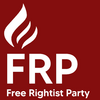 |
Free Rightist Party
"Rightist Party" |
FRP | Wyatt Baek | Right-wing | European Conservatives and Reformists | Libertarian conservativism | |
 |
People's Liberal Party
"Liberal Party" |
PLP | Chelsea Chen | Center-left | Progressive Alliance of Socialists and Democrats | Modern liberalism | |
 |
Righteous Reformist Party
"Reformist Party" |
RRP | Connor Holdsworth | Far-right | Identity and Democracy | Religious nationalism | |
 |
Socialist Republic Party
"Republic Party" |
SRP | Connor Hetner | Far-left | The Left in the European Parliament | Libertarian communism | |
 |
Centrist Radical Party
"Radical Party" |
CRP | Clayton Walker | Center-right | European People's Party | Radical centrism | |
| AMASHDRCPCKJUNOSR Party
"AMASH Party" |
Gabe Itchez | Right-wing | European Conservatives and Reformists | Satire | |||
| Nationalist Union Party
"Nationalist Party" |
Daniel Hu | Far-right | Identity and Democracy | Neoconservatism | |||
Official standards
Official standard flags are used to represent a certain branch of the government of the Federated States of Gapla, and are used along with the national or state flags, if applicable.
The following is a list of official standards of the Federated States of Gapla.
| Name | Flag |
|---|---|
| Standard of the President | 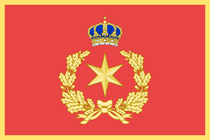
|
| Standard of the National Assembly | 
|
| Standard of the Supreme Court | 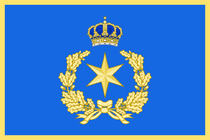
|
| Standard of the Armed Forces | 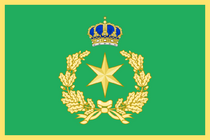
|
| Standard of the Monarchy
For standards of each member of the royal family, see List of Gaplan peers. |
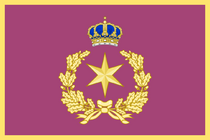
|
Seals of offices
Gapla has several seals for its official offices, namely the President, Deputy President, Speaker of the National Assembly, and Leader of the Opposition. These are widely regarded as the four most important seats in the country with exception to the Sovereign Prince, which is a part of the Gaplan monarchy.
The official seals of office are below.
| President | Deputy President | Speaker of the National Assembly | Leader of the Opposition |
|---|---|---|---|

|
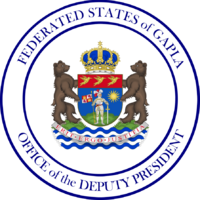
|
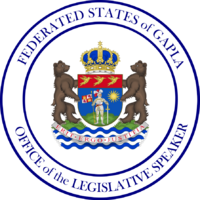
|
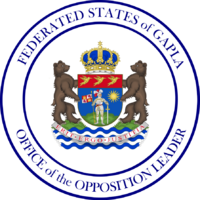
|
Land
The Federated States of Gapla claims land in several venues.
Regions

The following are the federally recognized regions of Gaplan territory:
- The western region includes all of the territorial claims located near the macronational cities of Irvine, Tustin, or Santa Ana), and is primarily residential. Its total area is a little under one acre and is the smallest yet most populated region of Gapla.
- The eastern region consists of the Governor of Elemental's two houses annexed from Nevada, as well as a few houses in Australia and Vietnam that are parts of the Gaplan Overseas Lands of the Newlands and the UDR. In addition, it contains the residential territory of New Gaplastovia, located near Albuquerque. This region is used to group all residential land not located near Southern California.
- The Mogollon region (synonymous with the territory of the city of Mogollon) consists of territories granted during Eovnia Pual's encounter with the U.S. Forest Service. The entire territory of the region was annexed from Arizona, and the region has a population of approximately ten people.
- The Antarctic region (synonymous with the territory of the Gaplan Antarctic Territory) consists of previously unclaimed sea ice, as well as a portion of Antarctica considered to be terra nullius due to an invalid territorial claim by Chile. Due to its inhabitability, the region has no population.
- The Danubian region (synonymous with Greater Danubia) consists of the pockets of land between Serbia and Croatia claimed by Gapla (New Gaplastovia proper and Cristus). The region has no permanent population.
Verification processes
The Federated States of Gapla employs strict verification processes to avoid claiming land that it is not authorized to claim. Land in most territories is exempt from verification.
The verification process for residential land is that a state must meet at least two of the below requirements to have verified land.
- Appearance on public records
- Certification of address through mailing
- Certification of address through random weekly governmental visit
- Governor IP address location approximation check
The verification process for non-residential land (that has previously been claimed by another entity) is that an entity must meet at least one of the below requirements.
- Proof of permanent sovereignty
- Proof of granted sovereignty of the land by the former entity
Geography, climate, and weather
The city of Elemental City and surrounding territories has a fairly flat geography, with a warm climate. The climate data for Elemental City can be applied to all Gaplan states except for outlying regions of Elemental, Mogollon, New Gaplastovia, Greater Danubia, and the Gaplan Antarctic Territory.
Below is a chart of the climate data for Elemental City.
| Climate data for Elemental City, Federated States of Gapla | |||||||||||||
|---|---|---|---|---|---|---|---|---|---|---|---|---|---|
| Month | Jan | Feb | Mar | Apr | May | Jun | Jul | Aug | Sep | Oct | Nov | Dec | Year |
| Average high °F (°C) | 66 (18.9) |
67 (19.4) |
68 (20) |
72 (22.2) |
73 (22.8) |
78 (25.6) |
82 (27.8) |
83 (28.3) |
82 (27.8) |
78 (25.6) |
72 (22.2) |
67 (19.4) |
73 (22.8) |
| Average low °F (°C) | 47 (8.3) |
48 (8.9) |
49 (9.4) |
51 (10.6) |
55 (12.8) |
59 (15) |
62 (16.7) |
63 (17.2) |
62 (16.7) |
57 (13.9) |
51 (10.6) |
47 (8.3) |
54 (12.2) |
| Average Precipitation inches (mm) | 2.95 (74.9) |
3.5 (89) |
2.85 (72.4) |
0.85 (21.6) |
0.26 (6.6) |
0.14 (3.6) |
0.03 (0.8) |
0.15 (3.8) |
0.3 (8) |
0.32 (8.1) |
1.05 (26.7) |
1.75 (44.5) |
13 (330) |
| Source: Weather.com | |||||||||||||
National holidays
Gapla's government declares national holidays that are unique to the nation. Currently, there are seven recognized holidays.
Holidays that are not unique to the country (such as Christmas) are not allowed to be recognized by the government but are still observed in practice.
The following is a list of officially declared and recognized government holidays.
- 28 February - Independence day
- 13 January - Freedom day
- 6 March - Union day
- 23 March - Constitution day
- 2 May - Government day
- 18 June - Princess day
- 24 August - National day
- 10 September - Revolution day
Leaders and elections
Leaders
Leaders, as in almost any country, are important leaders in their community.
Presidents of Gapla
The President of Gapla is the head of government of the Federated States of Gapla and is the most senior official in the government.
Gapla has one president at a time, and the term of a president is one year. They are elected once every two elections, which usually occur every six months.
Deputy Presidents of Gapla
The Deputy President of Gapla, formerly known as the Vice President, is the deputy head of government of the Federated States of Gapla and is the second most senior official in the government. They co-lead the government with the President and serve as an advisor as well as a policymaker.
Gapla has one Deputy President at a time, and the term of a president is one year. They are elected once every two elections, which usually occur every six months.
Elections
Gapla's elections are typically held every six months, unless a special circumstance arises, and are held through the STV (single transferrable vote) system, rather than the FPTP (first past the post) system used in most countries, such as the United States. Presidents and Deputy Presidents have a one-year term, which means that they are elected once every two elections, while the Speaker of the National Assembly and Leader of the Opposition are elected as leaders of their legislative party list.
The country is a republic and citizens directly elect executive offices while electing representatives through proportional representation.
Prior to Reform Acts of 2020, the electoral system was under a MGP (multiple graded points) system, in which ranked voting applied but candidates received "points" for the ranking they received on a voter's ballot rather than a transferrable vote.
Currency
Gapla's currency system is one of the most advanced in the micronational community due to the fact that it is traded and exchanged for fiat, printed on special paper with security features, and actually used as a recognized medium of exchange for everything from national credits, bakery goods, 3D prints, toys, crafts, websites, and more. The Gapla Dollar is the only legal tender in the Federated States of Gapla, but other mediums of exchange are allowed to be used.
A Bank of Gapla Discord bot was developed by the Ministry of Technology to keep track of users' balances, let users gift Gapla Dollars, let administrators manage balances, and more.
In addition, a Gapla Dollar stablecoin (GaplaCoin, GPC) was developed by the government. Initially, the cryptocurrency was not a success, with only six holders of GaplaCoin. This is likely due to citizens being unfamiliar with cryptocurrencies, ERC-20 coins, and the Ethereum network, as well as how to use them. However, the Gaplan government started an initiative to create an SPL-based Solana coin instead of an Ethereum one, which was easier to use. This effort was successful and the GaplaCoin is used alongside the Gapla Dollar, but its fiat form is still used more often due to its ease of use compared to the cryptocurrency.
Postage stamps
Traditional postage stamps are not used by the Federated States of Gapla due to the government's belief that they are pointless and can be replaced by digital, printable postage stamps.
Stamps can be paid for, generated, and printed at the national portal for stamps, which is at https://stamps.gaplagov.org/. Users can select a postal service and pay for stamps on the website through their Bank of Gapla account.
Identification
The Federated States of Gapla issues several types of identification, including passports, visas, and license plates.
The national I.D. card has been discontinued, however, the process of its recreation as an optional internal passport is under consideration.
Gaplan visa

The Gaplan visa is a document that allows holders to temporarily enter the Federated States of Gapla, with the exception of personal property, until expiry or revocation. The Executive Council has the right to revoke a visa with a majority at any time.
However, the Gaplan Constitution permits "invisible visas" - visas granted to people by a governor permitting them to enter their state, or a mayor permitting a person to enter their city, and so on and so forth. These visas are only applicable to one Gaplan subdivision and are immediately revoked once the visit is over.
These visas were likely created due to the fact that the Gaplan government does not wish to issue a visa for every nonimportant visit to a governor's state, especially when the states are homes and these entries are brief and frequent.
Gaplan passport

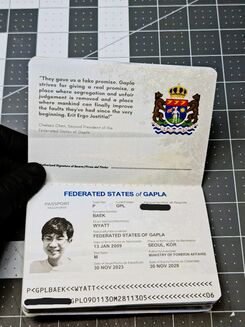
The Gaplan passport is an international travel document with a front cover, inside front cover, pages for visas, stamps, and amendments, and back cover. It is the standard international travel document for all Gaplan citizens and is optional.
The design of the Gaplan passport is shown in the images. The cost for issuance is 50 USD, and is only issued to citizens of Gapla who have met certain security clearance requirements.
Diplomatic and official versions of the passports are not offered, instead, Gaplan citizens place a sticker in their passport that allows for digital verification of its authenticity in order to save costs and ensure that it is only used when needed.
Gaplan license plate

The license plate of the Federated States of Gapla is put on cars (and is optional as a sign of patriotism on bikes) inside the Federated States of Gapla to certify vehicle registration. A license plate is not strictly required - however, if no license plate is on a car, the car can only drive on private roads, not government-owned ones. The cost for issuance is 50 USD.
Cases involving crashes or other damage to a vehicle without a valid license plate on the side of the victim will not proceed.
While its earlier rendition, printable out of paper, was popular during the early eras of Gapla, the license plate has little practical use as of the present day and is very rarely seen, and its use is de facto limited to government and postal bikes and vehicles.

